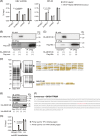CRISPR-mediated proximity labeling unveils ABHD14B as a host factor to regulate HBV cccDNA transcriptional activity
- PMID: 40658808
- PMCID: PMC12263051
- DOI: 10.1097/HC9.0000000000000757
CRISPR-mediated proximity labeling unveils ABHD14B as a host factor to regulate HBV cccDNA transcriptional activity
Abstract
Background: The long-term goal of chronic hepatitis B research is a functional cure (HBsAg seroclearance). Although currently used nucleos(t)ide analogs can efficiently inhibit viral replication, they do not reduce viral RNAs or proteins produced from covalently closed circular DNA (cccDNA), and rarely achieve a functional cure. To overcome this situation, revealing the mode of the existence of cccDNA is required, including identifying the interreacting proteins with cccDNA. Here, we aimed to identify novel proteins that interact with cccDNA.
Methods: Using an in vitro HBV infection model and a sequence-specific proximity labelling method consisting of dead Cas9 and biotin identification (BioID2), we comprehensively determined proteins that possibly interact with cccDNA. After identifying the candidate proteins, the HBV RNA transcription levels were examined by knocking out the associated genes.
Results: We identified ABHD14B as a protein that interacts with cccDNA and inhibits HBV RNA transcription from cccDNA. ABHD14B decreases the acetylation levels of histone proteins that control the transcription levels of HBV RNA in cccDNA. Moreover, ABHD14B interacts with TFII-I, which binds directly to cccDNA in a sequence-dependent manner. These results suggest that the host protein, ABHD14B, is recruited to cccDNA via the TFII-I protein, inhibiting HBV RNA transcription from cccDNA by deacetylating cccDNA histones.
Conclusions: ABHD14B was newly identified as a suppressor of HBV RNA transcription from cccDNA, which may improve our understanding of the mode of existence of cccDNA, providing a basis for development of a functional cure.
Keywords: ABHD14B; HBV; cccDNA; dCas9; proximity labelling.
Copyright © 2025 The Author(s). Published by Wolters Kluwer Health, Inc. on behalf of the American Association for the Study of Liver Diseases.
Conflict of interest statement
The authors have no conflicts to report.
Figures






References
MeSH terms
Substances
LinkOut - more resources
Full Text Sources

